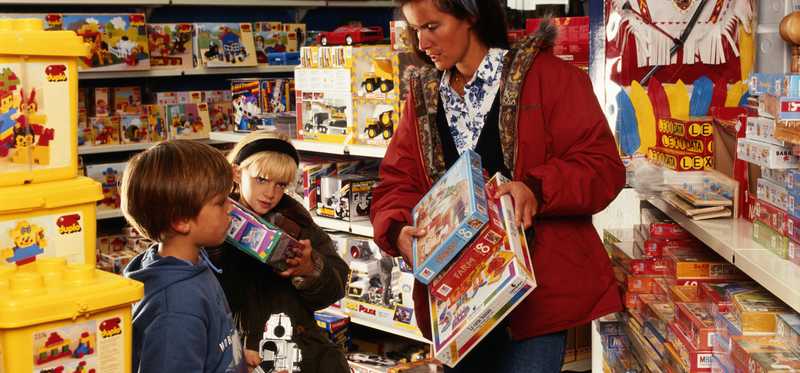15 Financial Things to Teach Your Kids

15 Financial Things to Teach Your Kids
Raise money-smart kids
Among the many important things to impart to your children is how to make smart financial decisions. Ideally, you'll do so throughout their childhood, teaching them basic concepts when they're young and elaborating more in later years. Do so and they may save money throughout their lives, avoiding dangers like credit card debt and gambling. They may even retire early and wealthy!
Here are 15 important things to teach them about money.
5 Stocks Under $49
Presented by Motley Fool Stock Advisor
We hear it over and over from investors, “I wish I had bought Amazon or Netflix when they were first recommended by The Motley Fool. I’d be sitting on a gold mine!" It's true, but we think these 5 other stocks are screaming buys. And you can buy them now for less than $49 a share! Click here to learn how you can grab a copy of “5 Growth Stocks Under $49” for FREE for a limited time only.
Previous
Next

1. How money grows
You might start with a carrot -- show them how money can grow over time. Inspire them with the power of compounding. If they're old enough to handle a little math, show them that if they can save and invest just $500 once, it can grow to almost $11,000 over 40 years. Even if they're young, they may grasp that small sums can become big sums over time -- and that those big sums can help them reach their dreams, such as having a big house, fancy car, or all the candy they would ever want.
ALSO READ: Compound Interest and Compounding Growth: A Comprehensive Guide
Previous
Next

2. The value of money
A key lesson for young people to learn, perhaps obviously, is the value of money. Kids should grasp that money isn't just freely available and that, instead, it generally needs to be earned. If you choose to pay them for chores done or books read or certain grades achieved, they can connect a certain value -- such as $10 -- with a certain amount of effort, like a half-hour mowing the lawn. You might help them along by offering an example of a working person who earns, say, $15 or $20 per hour. Show them how much that person will earn over time.
Previous
Next

3. Smart spending
Next, kids should learn how to be smart in their spending. You might introduce the concept of what they need versus what they want. They might want a certain jacket, but need a new pair of sneakers -- so the sneakers should take priority over the jacket. And if there isn't enough money, the jacket should remain on a wish list. You could continue the lesson, explaining that while they might want a $150 pair of sneakers, a $50 pair will do.
Previous
Next

4. Opportunity cost
A valuable economic term for all of us to know is the concept of opportunity cost: Spending a certain sum on one thing means that it can't be spent on something else. Choices will have to be made, and it's smart to compare two options to see which offers the best payoff. This applies to kids with limited funds and to adults, too. Spending $50,000 on a new car may mean there's no money available to buy shares of a promising stock. If you buy a $30,000 car, though, you might invest the remaining $20,000 and see it grow in value over time.
Previous
Next

5. Comparison shopping
Young people would do well to learn the value of comparison shopping and getting a good deal in order to save money. For example, they might want to buy a fancy pair of sunglasses that they see in a store selling for $40. But a little digging online, perhaps at Google's Shopping nook, might turn up a lower price for the same sunglasses at a different store. Teach them to look for sale prices, coupons, and other discounts. The less they spend on various items, the more will remain to spend on other items.
5 Stocks Under $49
Presented by Motley Fool Stock Advisor
We hear it over and over from investors, “I wish I had bought Amazon or Netflix when they were first recommended by The Motley Fool. I’d be sitting on a gold mine!" It's true, but we think these 5 other stocks are screaming buys. And you can buy them now for less than $49 a share! Click here to learn how you can grab a copy of “5 Growth Stocks Under $49” for FREE for a limited time only.
Previous
Next

6. Credit cards and other loans
Life as an adult involves frequently being offered credit cards. Train your kids to be smart about them. You might start by just introducing the concept of credit -- of borrowing money. Explain that using a credit card means you're borrowing money and will be charged interest if you don't pay off your debt pronto. Explain how credit is used for car loans, buying homes, and more.
Previous
Next

7. The dangers of credit card debt
All people, young and old, should be aware of the dangers of credit card debt. Some loans, such as mortgages that carry relatively low interest rates, are not that problematic and can even be unavoidable if you want to buy a home. But expenses charged to credit cards that can't be paid off quickly can add up and result in financial disaster, because credit cards tend to charge steep interest rates. Even when interest rates were very low in recent years -- when banks were offering interest rates below 1% on deposits -- credit cards were typically charging interest rates in the mid-teens and often 25% or more. Explain how if you end up with $10,000 of debt and an interest rate of 20%, you'll be on the hook for annual payments of around $2,000 -- just for the interest alone.
Previous
Next

8. The dangers of gambling
If you can get the message across to your kids that gambling can be very costly and is generally not a good idea, you might save them a world of pain in adulthood. It can be very tempting to buy a lot of lottery tickets every time there's a big jackpot, but that's extremely likely to result in a jackpot lost, not won. There are many different ways to gamble, and young people should learn to spot them. You might point out that Las Vegas, with all its glitzy casinos and miles of neon glamour, keeps those lights on and builds new casinos with dollars lost by gamblers. Gambling-related businesses are designed to profit from money wagered by gamblers, not to dispense frequent and easy payouts.
Previous
Next

9. What things cost
It's also valuable for your young ones to have an idea of what various things cost -- especially when they're in their teens. Many kids have little idea what a typical house costs in their neighborhood, what a new car (and a used car, too, for that matter), a jug of milk, a month of electricity, and lots of other things cost. You might have them watch you pay bills, so they get a sense of the expenses your household incurs. You might also check out prices of things that interest them, such as cars, vacations, phone services, and so on.
ALSO READ: American Households' Average Monthly Expenses: $5,111
Previous
Next

10. Getting more money -- from banks
As your kids get older, they may start getting interested in having more money. They may be able to simply earn more from you, for chores or other tasks, and they may receive an allowance, too. But you can start talking about other ways to get more money. For example, via interest from banks. Explain how a bank collects money from depositors and pays interest while loaning out that money and charging a higher interest rate. You might discuss how interest rates change over time, too. For many years now, rates have been very low, and they've begun rising. You can mention that rates were in the high teens briefly in the 1980s, and that if they had $500 in the bank earning 16%, they'd collect a hefty $80 over a year.
5 Stocks Under $49
Presented by Motley Fool Stock Advisor
We hear it over and over from investors, “I wish I had bought Amazon or Netflix when they were first recommended by The Motley Fool. I’d be sitting on a gold mine!" It's true, but we think these 5 other stocks are screaming buys. And you can buy them now for less than $49 a share! Click here to learn how you can grab a copy of “5 Growth Stocks Under $49” for FREE for a limited time only.
Previous
Next

11. Getting more money -- from stocks
The stock market is another excellent way to make money -- as long as you're doing so over the long term, such as many years. Over the short term, such as a few days, months, or even years, the stock market might decline, shrinking your investment's value. But over long periods, it has always gone up. Explain to your kids that a share of stock is an actual ownership stake, admittedly a small one, in a real company. So if the company grows and prospers, the share will likely increase in value -- and vice versa.
Previous
Next

12. Getting more money -- from work
A great way for older kids to get more money is from working. They might get a part-time job -- or they might even go into business for themselves. If they have some skills, such as playing an instrument or speaking a language, or even are simply really good at math, they might teach or tutor others. If they are good at knitting or making jewelry or woodworking, they might make and sell things. If they're good at programming, they might create useful apps and try to sell them. There can be lots of money-making opportunities in their neighborhood, too -- such as mowing lawns, shoveling snow, babysitting, or walking dogs.
Previous
Next

13. Budgeting
It's handy for all of us to have a budget to stick to, so that our money gets spent in ways we want, and so that various intended expenses don't fall through the cracks. A simplified budget can work best for kids, and there are many possible models. When kids are young, you might have them divide their income equally into three buckets (or piggy banks) -- one for spending, one for saving, and one for giving away. With your guidance, that last part can help them value helping others. You might identify charitable causes and organizations of interest, to start.
As kids get older, you might tweak the categories and/or allocation. One suggestion is a 50-30-20 rule, which allows spending 50% on needed things, 30% on things one wants, and 20% on savings -- for long-term spending goals such as an extra week at summer camp or concert tickets.
ALSO READ: Budgeting 101: How to Start Budgeting for the First Time
Previous
Next

14. Talking about money
In many households and even in society at large, there's a taboo regarding talking about money. That's a shame, because couples, friends, and family members who routinely talk about financial matters -- such as goals, concerns, and achievements -- can benefit greatly. If you and your spouse are discussing whether or not to buy a new house, let your kids in on the discussion, including financial pros and cons. If money is tight and you're discussing which bills to pay first, let your children witness that, too. As a family, you might regularly share financial goals and support one another as you work toward achieving them.
ALSO READ: Should You Teach Your Kids About Money? Here's What Kevin O'Leary Says
Previous
Next

15. Getting smarter by reading up on money
All of us, whether we're still in school or have 50 years of investing experience under our belt, can benefit by continuing to learn about financial matters and investing. There are many books out there these days directly targeting young people, aiming to make them savvier about money. One example is our own Motley Fool Investing Guide for Teens by David and Tom Gardner with Selena Maranjian. A little online searching will turn up many other possibilities, such as Make Your Kid a Money Genius (Even If You're Not): A Parents' Guide for Kids 3 to 23 by Beth Kobliner; The Everything Kids' Money Book: Earn It, Save It, and Watch It Grow! by Brette Sember; and The Early Investor: How Teens & Young Adults Can Become Wealthy (Investing Fundamentals for Wealth Creation) by Michael W. Zisa.
Consider spending time at websites such as Fool.com, too, where we have gobs of articles on investing basics, as well as articles on companies in the news and stocks that are poised to perform well.
5 Stocks Under $49
Presented by Motley Fool Stock Advisor
We hear it over and over from investors, “I wish I had bought Amazon or Netflix when they were first recommended by The Motley Fool. I’d be sitting on a gold mine!" It's true, but we think these 5 other stocks are screaming buys. And you can buy them now for less than $49 a share! Click here to learn how you can grab a copy of “5 Growth Stocks Under $49” for FREE for a limited time only.
Previous
Next

Start now!
It's probably not too soon to start teaching your young ones about money -- unless they still have a pacifier in their mouth. Remember that the earliest invested dollars will have the longest time in which to grow, so a 15-year-old's earliest invested dollars might have 50 years to grow, until retirement. Depending on the age and readiness of your kids, choose some of the suggested actions mentioned here and start making them savvy about money. You'll thank yourself later, when they're financially responsible and even financially independent adults.
The Motley Fool has a disclosure policy.
Previous
Next
Invest Smarter with The Motley Fool
Join Over Half a Million Premium Members Receiving…
- New Stock Picks Each Month
- Detailed Analysis of Companies
- Model Portfolios
- Live Streaming During Market Hours
- And Much More
READ MORE
HOW THE MOTLEY FOOL CAN HELP YOU
-
Premium Investing Guidance
Market beating stocks from our award-winning service
-
The Daily Upside Newsletter
Investment news and high-quality insights delivered straight to your inbox
-
Get Started Investing
You can do it. Successful investing in just a few steps
-
Win at Retirement
Secrets and strategies for the post-work life you want.
-
Find a Broker
Find the right brokerage account for you.
-
Listen to our Podcasts
Hear our experts take on stocks, the market, and how to invest.
Premium Investing Services
Invest better with The Motley Fool. Get stock recommendations, portfolio guidance, and more from The Motley Fool's premium services.